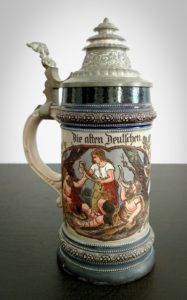 More than any spirit container, I love German Beer Steins the best. So when KL sent me his, I translated it. On one side, Die alten Deutschen, the old-time German, and on the other, Die Deutschen von heut, the German of today. Since this hails from circa 1890, we see an acute picture of the Germans of the 1890s. Top hats, caps, vests and cut away coats, riding breeches and boots, and the landlady with a change purse and white apron. Notice the landlady has a hand on her hip, as if to say, “I gave you one full beaker of beer, and now you order another glass before the beaker is finished…where’s the money?”
More than any spirit container, I love German Beer Steins the best. So when KL sent me his, I translated it. On one side, Die alten Deutschen, the old-time German, and on the other, Die Deutschen von heut, the German of today. Since this hails from circa 1890, we see an acute picture of the Germans of the 1890s. Top hats, caps, vests and cut away coats, riding breeches and boots, and the landlady with a change purse and white apron. Notice the landlady has a hand on her hip, as if to say, “I gave you one full beaker of beer, and now you order another glass before the beaker is finished…where’s the money?”
Contrast this with the “Germans of yesteryear” on the other side. No greedy landlady here, just a nubile peasant girl serving beer in the hollowed horns of cattle. The bearded drinkers lie among the trees, holding hunting gear, wrapped in furs, wearing Roman sandals. I think this vision less than precise, nostalgic for the old times when beer was free and passed by someone pretty.
Steins were made of stoneware, and lidded, to keep out the flies, which were known as far back as the Black Death (Plague of 1347-1351) to carry disease. The origin of the stein lid dates from this period.
By the 19th century, steins became an art form
Look for the great stein makers: Villeroy and Boch, Martzi and Remy, Dümler & Breiden, and of course the German Military Regimentals. Haber and Reuther, of Freising, Bavaria, made KL’s stein with a HR mark underneath.
 The golden age of German steins, 1880-1910, is highly collected today, mainly because of the combination of imagery, calligraphy, and significant German sayings. These sayings are those one might hear BEST when drunk, such as this one on another HR stein, picturing a buxom barmaid and a handsome student, “Hand me another beaker, sweetheart, give me one, otherwise I am sober and alone on earth.”
The golden age of German steins, 1880-1910, is highly collected today, mainly because of the combination of imagery, calligraphy, and significant German sayings. These sayings are those one might hear BEST when drunk, such as this one on another HR stein, picturing a buxom barmaid and a handsome student, “Hand me another beaker, sweetheart, give me one, otherwise I am sober and alone on earth.”
Imagery is a clue to the character of the turn of the century nostalgic German mind, at least those of the drinker’s nostalgic frame of mind. You will find glorification of the botany that makes up beer, paintings of barley and hops, wreaths, brewing symbols. Also, setting images, hunters and fox, barmaids, taverns, music halls, students. You’ll find the sweet things of life themes, pretty female drinkers, musicians, card games, dogs, more pretty girls, dancers, and green forests. Along the best things in life, you’ll see men kissing barmaids, wrestling barmaids, peasant dancing couples flirting, grapevines around blond heads of hair, children drinking, drunken men sleeping in wagons, drinkers on horseback…
In the realm of fantasy themes, the German gnomes. Then we find the situational themes. I see this particular theme in paintings of the period, the drunken fat Monk or Nun, jolly, dressed in a brown cassock, with a stein or even wine decanter lifted. The apex of this genre is a troop of monks in the wine cellar of the monastery, tempted by the wine. The image pictures them opening the spigots of the 500lb casks, crawling under the spigots, with open and greedy mouths. The history of brewery and wine making WAS the CHURCH, thus the jolly association.
Perhaps the most coveted of all themes on German beer steins is the image of Gambrinus. That legendary-god-figure, in German myth, derived from the real life Jan Primus (Johann I) a 13th century Belgian Duke and President of the Brussels Guild of Brewers. He is famed throughout Northern European history for the invention of hopped malt beer. The steins that feature Gambrinus show us the universal symbol of beer and brewing. And he ALWAYS appears drunk or well on his way.
From the mythological, one sometimes sees the modern era, the bicycle, the steamship, the military caisson, the rowing skiff, the woman in a bustle, a man with muttonchops sideburns.
Many of these scenes are homey or low-brow, and indeed, the makers designed them in that direction. The simple life of the worker and the working man himself was the market for these steins. He brought his very own stein to his neighborhood tavern, and it stayed there in perpetuity. These colorful steins hung on the back bar waiting for the workers after a day’s labor.
Your stein was yours and no others. That’s another reason for the lid with a tight seal, nobody washed these mugs.
The value of KL’s stein is $300.